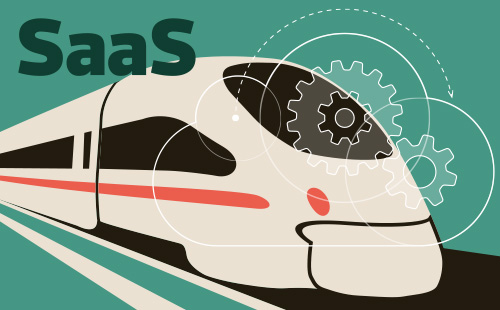Estimated reading time: 4 minutes

One of the more popular sessions in the VARTECH Education Series was the “Supporting a SaaS Business “ workshop featuring Hunter Allen with Cervion, and Aaron Kaplan with HPFS (Hewlett Packard Financial Services).
Hunter candidly shared the benefits and hurdles he faced when converting his company from the traditional to a SaaS business model. He  stared the session with the words “My hair is grey.” The cyclical sales cycle, stressful vendor relationships, dialing for dollars, and the impact on sales by things he could not control, resulted in stress at home, work and in the lives of his staff, as well. With no long term value or exit plan he needed to design a business model that would deliver a predictable revenue stream, increase business assets, give the company a greater valuation and ultimately, allow him a good night sleep.
stared the session with the words “My hair is grey.” The cyclical sales cycle, stressful vendor relationships, dialing for dollars, and the impact on sales by things he could not control, resulted in stress at home, work and in the lives of his staff, as well. With no long term value or exit plan he needed to design a business model that would deliver a predictable revenue stream, increase business assets, give the company a greater valuation and ultimately, allow him a good night sleep.
The Program Breakdown
The program consists of: providing a POS System to a customer for a nominal installation fee and monthly use fee. Monthly fees include the use of hardware, software, support and upgrades. He retains the ownership of the POS system and the customer only pays as long as they use the system. He can also bundle payment processing to increase his monthly revenue.
He gave comparative examples of revenue that could be expected over a 36-month period for the traditional purchase of equipment, POSaaS, and a lease option. He explained when presenting the options, that unless the customer has money in the bank for the purchase, the only options remaining are POSaaS or a lease option; and he has a 100% win rate when proposing his SaaS option versus the lease program.
The Obstacles
Hunter noted that the conversion was not without obstacles, such as:
- Hardware and software acquisition
- Sales support (agreements, documents, etc.)
- The sales process (including compensation)
He suggested looking for alternate sources when purchasing equipment. Many resellers have a stock room full of used or reclaimed equipment, so start there. Find a financing partner. Contact software companies and see if they can provide their product via a subscription service, deferring the upfront cost of purchasing the software.
He suggests joining an association such as RSPA, who can provide the agreements and documents needed to administrate the program at no additional charge and find a compensation plan that works for your sales team. This could come in the form of recurring compensation based on recurring revenue, or paying at the time of the sale.
He has experimented with both and has come full circle. Originally, he compensated based on residual revenue, but found the sales group was less motivated to pick up the phone on a daily basis because they knew they were going to get paid on recurring contracts.
This can cause rep cash flow issues, but eases upfront cash that the business has to supply. Today he is paying commission upfront…at the time of the sale. This plan allows his sales reps pay their bills today, but increases the upfront financial burden on the business. The compensation plan is fluid as he is still tweaking to ultimately insure his sales staff is happy and motivated to develop new sales/leads.
How do I convert my business model to SaaS without a huge financial burden at start up?
“Start by selling one system as a service this month. Next month sell two systems, then three, etc. In time, you will have enough recurring revenue to support your business. This will allow you to slowly convert without totally changing the way you do business today.”
Presenter 2: Aaron Kaplan of HP Financial Sercies
 Up next, Aaron Kaplan with HPFS presented a Hybrid SaaS partnership with Mercury Payment Systems and pcAmerica in which the end user would make affordable monthly payments, eliminating up-front capital expense, and the reseller would get their money at the time of the sale, keeping their revenue stream intact.
Up next, Aaron Kaplan with HPFS presented a Hybrid SaaS partnership with Mercury Payment Systems and pcAmerica in which the end user would make affordable monthly payments, eliminating up-front capital expense, and the reseller would get their money at the time of the sale, keeping their revenue stream intact.
“It was our way to help you bridge that gap for transitioning your business to the recurring revenue business model. Our financing staff has been working
on this for two to three years. And the packages we’ve put together have high margins.” said Aaron Kaplan.
With the reseller being paid up front, the solution eliminates the problems of how to compensate sale reps and dealing with collections on monthly bills.
Why HP subscription? Value within the Channel by helping boost orders and margins, receive full revenue at time of sale, quick decision process, and ease of use for customers to quickly access and understand.
Sales benefits including increased value by improving attach rates, increased customer acquisition and retention, system refreshes occur at year 2 -3 instead of year 5 as will tradition equipment, and a simplified subscription cycle with HPFS.
Aaron provided screenshots of the HPFS partner portal that will allow the reseller to provide a quote, obtain credit approval, and generate all documents pertaining to the agreement. The reseller will also receive a reminder when the subscription’s end of term approaches signaling the time to start sales cycle again, thus providing the opportunity for additional sales.
One of the recurring questions with Aaron’s presentation was: “What are the margins with this program?” Aaron gave no specific answer, but to say they are significant.

